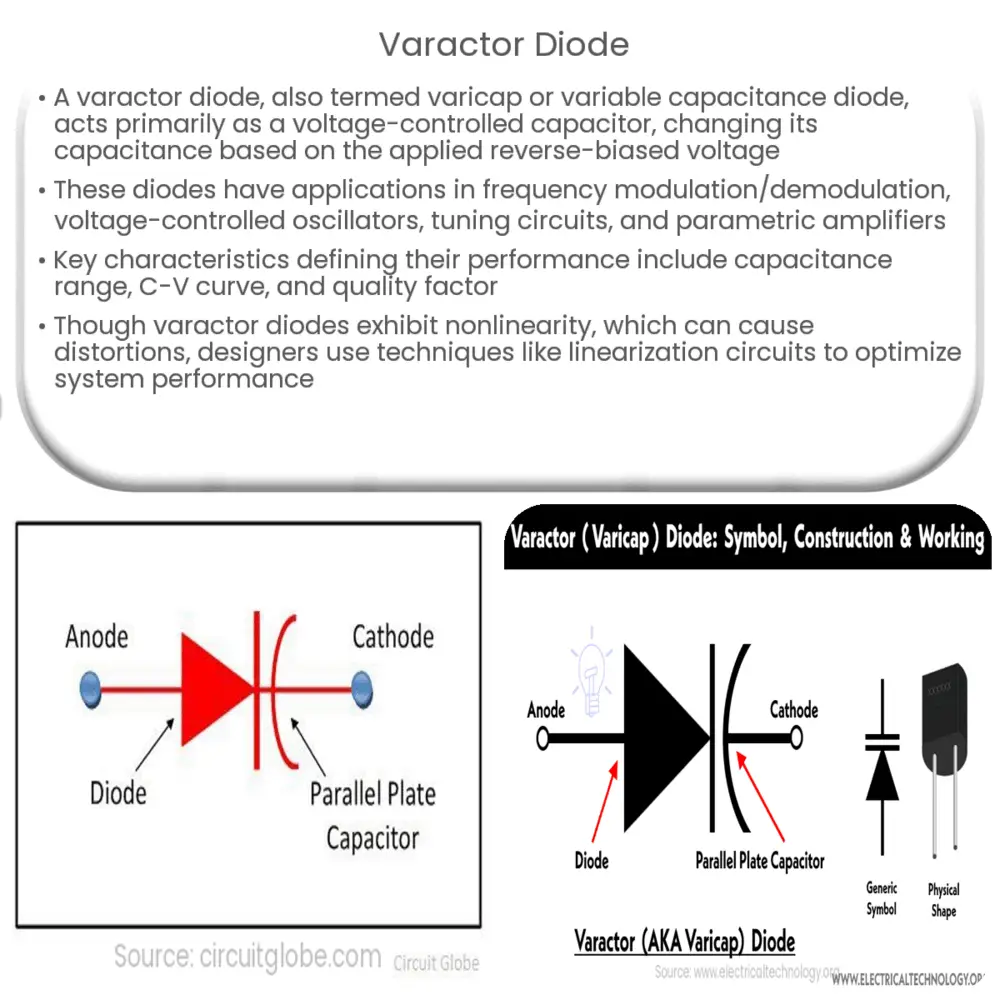A varactor diode is a voltage-controlled semiconductor device that offers variable capacitance, widely used in tuning and frequency modulation applications.

Varactor Diode: Introduction, Applications and Characteristics
Introduction to Varactor Diodes
A varactor diode, also known as a varicap diode or variable capacitance diode, is a specialized diode that has the unique ability to vary its capacitance based on the applied reverse-biased voltage. Unlike conventional diodes that primarily conduct current in one direction, the varactor diode’s primary function is to act as a voltage-controlled capacitor.
The varactor diode’s behavior is a result of the depletion region formed at the semiconductor junction when it is reverse-biased. The width of the depletion region is inversely proportional to the applied reverse-biased voltage, and the capacitance is directly proportional to the width of the depletion region. Thus, as the reverse-biased voltage increases, the capacitance decreases, and vice versa.
Applications of Varactor Diodes
Varactor diodes find wide-ranging applications in electronics due to their ability to provide a variable capacitance, which can be controlled by adjusting the reverse-biased voltage. Some common applications of varactor diodes include:
- Frequency Modulation and Demodulation: Varactor diodes are commonly used in FM modulators and demodulators to generate and extract frequency-modulated signals. By varying the capacitance of the varactor diode, the frequency of the output signal can be controlled, resulting in frequency modulation or demodulation.
- Voltage-Controlled Oscillators (VCOs): Varactor diodes are used as key components in VCOs, where the output frequency of the oscillator can be controlled by adjusting the reverse-biased voltage across the varactor diode. This is useful in applications such as frequency synthesizers and phase-locked loops (PLLs).
- Tuning Circuits: In RF and microwave circuits, varactor diodes are often used to adjust the resonance frequency of resonant circuits. They are also used in electronically tunable filters, impedance matching networks, and antenna tuning units.
- Parametric Amplifiers: Varactor diodes can be used as parametric amplifiers, where they provide gain by converting energy from a pump signal to an input signal through a nonlinear capacitance process.
Characteristics of Varactor Diodes
There are several key characteristics that define the performance of a varactor diode, including:
- Capacitance Range: The capacitance range of a varactor diode is the difference between its maximum and minimum capacitance values. A larger capacitance range allows for more precise control of capacitance and, in turn, better tuning capabilities.
- Capacitance-Voltage (C-V) Curve: The C-V curve describes the relationship between the capacitance and the reverse-biased voltage applied across the varactor diode. This curve is crucial for determining the varactor diode’s performance in various applications.
- Quality Factor (Q): The quality factor, or Q factor, of a varactor diode is a measure of its efficiency as a capacitor. A higher Q factor indicates lower series resistance and better overall performance in applications where low loss and high efficiency are required.
Nonlinear Capacitance and Linearity
One of the challenges in using varactor diodes is their inherent nonlinearity. The capacitance of a varactor diode does not change linearly with the applied reverse-biased voltage, which can introduce distortion and harmonics in some applications. To overcome this issue, designers often use techniques such as linearization circuits, feedback loops, or predistortion algorithms to minimize the impact of nonlinearity on the overall system performance.
Selection and Design Considerations
When choosing a varactor diode for a specific application, there are several factors to consider:
- Capacitance Range and Tuning Ratio: Select a varactor diode with a suitable capacitance range and tuning ratio based on the application’s requirements. The tuning ratio is defined as the ratio of maximum capacitance to minimum capacitance and is a critical parameter for applications like VCOs and tunable filters.
- Linearity: Depending on the application, a more linear capacitance-voltage relationship might be desirable. In such cases, it is essential to select a varactor diode with better linearity or implement linearization techniques in the design.
- Quality Factor: For high-performance RF and microwave applications, a varactor diode with a high Q factor is preferable as it results in lower losses and better overall efficiency.
- Package Type and Size: Varactor diodes are available in various package types and sizes, ranging from surface-mount to leaded packages. Choose a package type that suits the design requirements and available space on the printed circuit board (PCB).
Conclusion
Varactor diodes play a critical role in modern electronics, enabling designers to create tunable and adaptable systems that can be controlled with precision. By understanding the fundamental principles of varactor diodes, their applications, and their key characteristics, engineers can make informed decisions when selecting and designing with these versatile components. While nonlinearity can be a challenge in some applications, various techniques can be employed to mitigate its effects, ensuring optimal performance in a wide range of use cases.
As technology continues to advance, we can expect varactor diodes to become even more essential in various industries, from communications and radar systems to medical devices and consumer electronics. With ongoing research and development, we may also see the emergence of new materials and design approaches that further improve the performance and capabilities of varactor diodes in the future.

